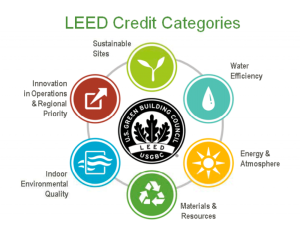If you’re in the midst of a new construction or renovation and are considering LEED certification, here’s a primer on how to successfully complete the process, and why it’s worth considering.
Why Take the LEED?
LEED stands for Leadership in Energy & Environmental Design, and is essentially a green building certification program for building projects. In order to earn a LEED certification, the project earns points based on the environmental impacts and human benefits of using particular building practices. There are different levels of certification depending on the number of points earned, and as a business owner, you must choose the type of LEED program that best fits your construction project. Your choices are:
- Building design and construction (BD + C)
- Interior design and construction (ID + C)
- Building operations and maintenance
- Neighborhood development
- Homes
[/bootstrap_column]
To get certified, you must earn 40-49 points; silver certification requires 50-59 points; gold needs 60-79 points; and platinum is for those that earn 80+ points.
If you need some bottom-line motivation as to why it’s worth going through the process and expense of becoming LEED certified, three key points to keep in mind include:
- LEED-certified buildings cost less to operate, reducing energy and water bills by as much as 40 percent, as per the U.S. Green Building Council (USGBC).
- LEED buildings have higher air quality and more comfortable work spaces for employees, creating a healthier and more comfortable environment that can increase productivity.
- Over 60 percent of corporate leaders believe that sustainability leads to market differentiation and improved financial performance, according to USGBC.
The Path to LEED
The first steps of the LEED process can be completed online, beginning with registration. You’ll have to submit a registration form and your flat registration fee of $1,200, which will open your LEED Online account. The certification fee will be based on the size of the project and the rating system under which you register, with pricing beginning at $2,750. Naturally, the higher the level of LEED certification you’re trying to achieve, the more expensive it will be.
From there, you’ll be able to access various tools, and given step-by-step instructions on the documentation you’ll need for your application. If you’re working on BD+C and ID+C projects, you will have the option to split the LEED review, in which you will submit your application in two parts: one for design credits, and the other for construction credits.
Once you’re ready to begin working on your project, be sure to choose professionals – from engineers to consultants to architects — who are LEED-accredited to ensure that the job gets completed according to LEED specifications, recommends the National Resources Defense Council.
All in all, investing in a greener business will have long-term benefits, can help you operate more efficiently, and will set you apart in the eyes of your customers and clients. LEED certification is a proven path toward sustainability.




